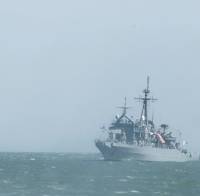"Iron Nickel's" Last Voyage
USS Peleliu (LHA 5) returned to Naval Base San Diego Dec. 24 from a six-month deployment to the Western Pacific. Upon return, the ship will make preparations to decommission in March after 34 years of service, 17 deployments and more than a million miles transited, and as the last remaining Tarawa-class amphibious assault ship. During the ship's deployment Peleliu, its crew, Commander, Amphibious Squadron Three, Special Purpose Marine Task Force Three and Helicopter Sea Combat Squadron (HSC) 21 participated in Rim of the Pacific (RIMPAC) 2014 as part of U.S. 3rd Fleet. Upon assignment to 7th Fleet, the ship embarked Commander, Amphibious Force Seventh Fleet…
This Day in U.S. Naval History – October 26
1921 - In first successful test, a compressed air, turntable catapult, launches an N-9 seaplane. 1922 - LCDR Godfrey deC. Chevalier makes first landing aboard a carrier (USS Langley) while underway off Cape Henry, Virginia. 1942 - Battle of the Santa Cruz Island. USS Hornet (CV-8) was lost and USS Enterprise (CV-6) was badly damaged during the battle. 1944 - Battle of Leyte Gulf ends with Navy carrier and USAAF aircraft attacks on the retreating Japanese ships. U.S. forces sink many Japanese ships including 4 carriers, 3 battleships, 10 cruisers, and 9 destroyers, for a total of 26 capital ships. Afterwards Japanese fleet ceases to exist as an organized fighting fleet.
US Navy Divers Support ROK Ship Recovery

Sailors of Mobile Diving and Salvage Unit (MDSU) 1, based out of Pearl Harbor, Hawaii, and Explosive Ordnance Disposal (EOD) Mobile Unit (EODMU) 5 Platoon 501 based out of Sasebo, Japan, are diving in the Yellow Sea in support of the recovery and salvage of the Republic of Korea Ship (ROK) Cheonan. "We're here to offer all the help we can. We're ready to step in anytime and dive or assist hands-on in any way we can," said Navy Diver 3rd Class Andrew Kornelsen, a Madison, Wis., native.
U.S. Support to ROK Salvage Ops Leadership Change
Commander, Amphibious Force Seventh Fleet, Rear Adm. Rich Landolt, has assumed the duties as the senior naval officer in charge of U.S. Navy assistance to the Republic of Korea (ROK) in their salvage efforts for the ROKS Cheonan Apr. Landolt has been on-site for several days to assess the situation and acclimate his staff to the mission. Additionally, he has met with the ROK lead for the salvage efforts, Vice Adm. Kim Sung-Chan, and his staff aboard ROKS Dokdo several times to coordinate future plans. His ship, USS Harpers Ferry (LSD 49), will serve as the U.S. Afloat Staging Base for this operation and he has brought with him portions of his staff and portions of Amphibious Squadron 11, commanded by Commodore Mark Weber. Landolt will command of all U.S.
This Day in Naval History – Oct. 26
1921 - In first successful test, a compressed air, turntable catapult, launches an N-9 seaplane. 1922 - LCDR Godfrey deC. Chevalier makes first landing aboard a carrier (USS Langley) while underway off Cape Henry, Virginia. 1942 - Battle of the Santa Cruz Island. USS Hornet (CV-8) was lost and USS Enterprise (CV-6) was badly damaged during the battle. 1944 - Battle of Leyte Gulf ends with Navy carrier and USAAF aircraft attacks on the retreating Japanese ships. U.S. forces sink many Japanese ships including 4 carriers, 3 battleships, 10 cruisers, and 9 destroyers, for a total of 26 capital ships. Afterwards Japanese fleet ceases to exist as an organized fighting fleet.
This Day in Navy History
October 26, 1921 - In first successful test, a compressed air, turntable catapult, launches an N-9 seaplane. 1922 - LCDR Godfrey deC. Chevalier makes first landing aboard a carrier (USS Langley) while underway off Cape Henry, Virginia. 1942 - Battle of the Santa Cruz Island. USS Hornet (CV-8) was lost and USS Enterprise (CV-6) was badly damaged during the battle. 1944 - Battle of Leyte Gulf ends with Navy carrier and USAAF aircraft attacks on the retreating Japanese ships. U.S. forces sink many Japanese ships including 4 carriers, 3 battleships, 10 cruisers, and 9 destroyers, for a total of 26 capital ships. Afterwards Japanese fleet ceases to exist as an organized fighting fleet.







